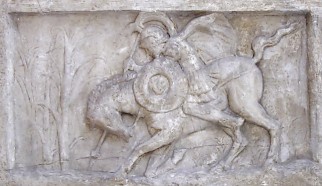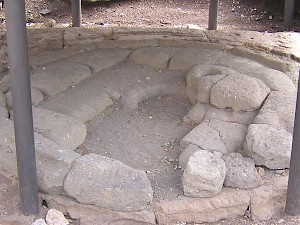Lacus Curtius
Q1232467Lacus Curtius ("lake of Curtius"): small pool on the Roman Forum, venerated by the Romans, even when they did no longer remember why it was a holy place.
For the website LacusCurtius, go here.

The Lacus Curtius is arguably the most mysterious monument on the Roman Forum. The name indicates that it was a lake, and it is very likely that in the most ancient times, there was a lake on the Forum. Archaeologists have established that in the Iron Age, the Palatine (the most important of the Roman hills) was on nearly all sides surrounded by brooks and marshes.
However, in the late seventh century BCE, the Forum area was drained. After a sewer had been made (the cloaca maxima), the area was paved. This is generally attributed to king Tarquinius Priscus. To the same period belongs the inscription on a monument that was discovered on a place called Lapis Niger ("black stone"). The precise meaning of the words of this archaic text is unclear, but it is reasonably certain that it contains regulations about the execution of profaners and the purification ceremony.

During the reorganization of the Forum area, one part was not drained and paved. During the centuries, this pool became even smaller, until a small dodecagonal basin was all that remained. It was called the Lacus Curtius.
The Romans had several explanations for the name. The most prosaic is that in 445 (according to the Varronian chronology), lightning struck the place, and consul Gaius Curtius Philo ordered the construction of a fence.note
But there was an older story. The historian Livy (59 BCE - 17 CE) tells us that after the Rape of the Sabine Women, war broke out between the Romans and the Sabines. The champion of the latter was a man named Mettius Curtius, but during the battle, he got stuck in the marsh; therefore, it was called Lake of Curtius.note

A third story tells that in 362 (still following the Varronian chronology), a great chasm opened on the Roman Forum. The seers were consulted, and the Romans learned that they had to throw "that what constituted the greatest strength of the Roman people" into the ravine. If they did, their empire would last forever. A warrior named Marcus Curtius understood the significance of the story: he mounted his horse, said that youth was the most important thing, and jumped into the chasm, which duly closed.
This story is told by Livy, who adds that he thinks that this devotio is more plausible than the tale of Mettius Curtius.note Only a few modern people will agree. After all, the story about the Sabine warrior does not presuppose the suspension of the laws of nature. Besides, it contains at least one authentic aspect: the name Mettius is a rendering of a real Sabine word, medìss, "leader". Worse, the story about the abyss appears to be a copy of a Greek story about the Phrygian king Midas.note

A bit to the east of the dodecagonal basin, the skeletons were discovered of a child, a woman and a man that were bound together and drowned in the lake. It is tempting to assume that the stories of Mettius and Marcus Curtius contain badly understood memories of a very ancient ritual, in which people were sacrificed by drowning them in the Lacus Curtius. Perhaps the three skeletons belong to the profaners mentioned in the inscription on the Black Stone.
Finally, it should be noted that the Lacus Curtius was the place where the emperor Galba was lynched by soldiers on the fifteenth of January 69. Seven months before, he had succeeded Nero, but all hopes that the old dynasty could peacefully be replaced by another system of rule were now gone.